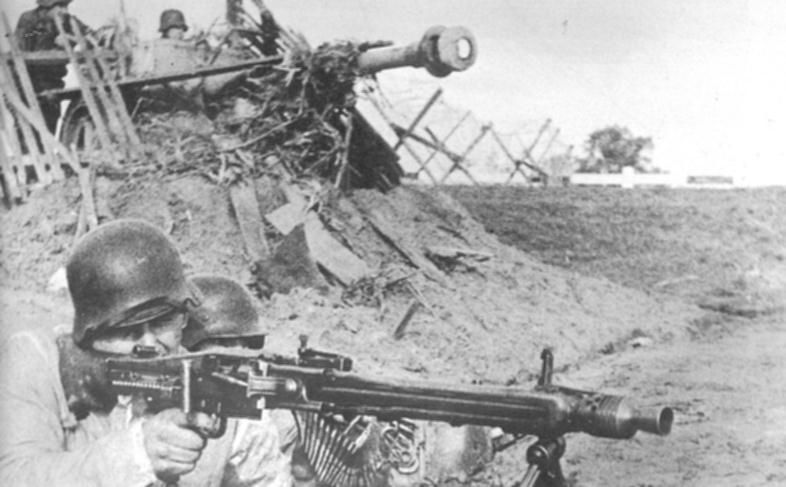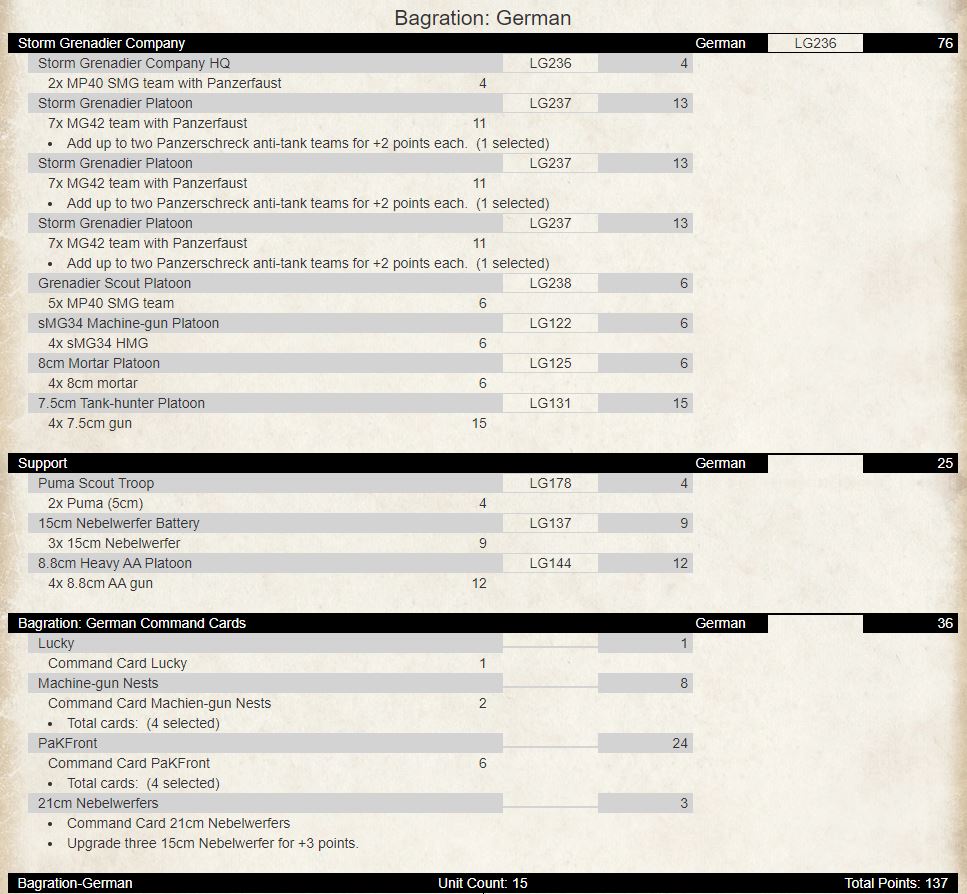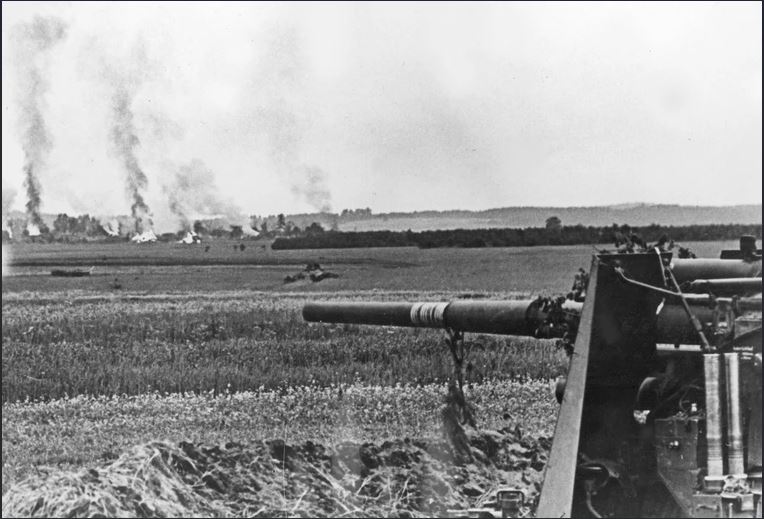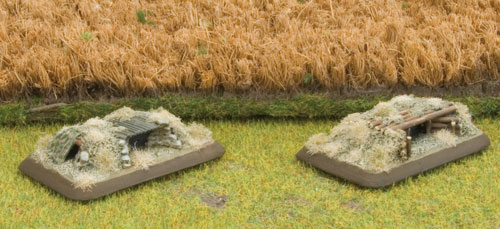With Adam Brooker
The 78. Sturmdivision or 78th Storm Division was one of the more famous German Wehrmacht divisions from the Eastern Front campaign. It was raised in Stuttgart Germany in 1939, and had fought all the way from the Polish border, through the Russian Steppes, and finally to the gates of Moscow in 1941 as part of Army Group Centre, in Operation Barbarossa. The division was finally turned back not only by stubborn Soviet defences but also “General Winter”, it then had to fight a series of defensive battles against the Soviet Winter Offensive in late 1941/early 1942, in the fighting known as the Rhzev Meat Grinder, due to the significant Soviet losses in man-power. Despite heavy losses for both sides, it was a strategic stalemate, with the Soviets unable to destroy Army Group Centre, and the Germans being forced to retreat from the Rhzev salient in Operation Buffalo (Büffel), to shorten their line and release some divisions to create a reserve.
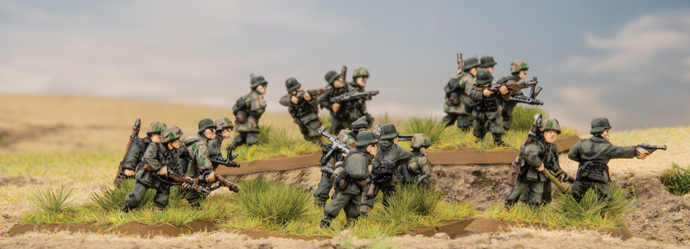
The 78. Infantry-Division (at the time) having taken heavy losses in the fighting was pulled back to reorganise. In early 1943 it was reorganised as the 78. Sturmdivision, with their Divisional symbol now becoming the armoured fist of Götz von Berlichingen, a famous 16th-century German knight, mercenary, and poet, who has lost his hand in battle, had a metal prosthetic made (and continued fighting for another 40 years….). He also invented a rather crude phrase, which you should google.
For example, each company was authorized 3 enlarged infantry platoons (with 2 light machine guns, instead of 1), a heavy platoon of two heavy machine-guns and two 81mm mortars, and two platoons of three PaK40 anti-tank guns. With 3 Regiments in the Division (14th, 195th, and 215th) and each Regiment having 2 Battalions, and 3 Companies per Battalion, it was a possible 18 Pak 40 per Battalion, and 108 for the whole Division.
In practice, they only ever achieved around eleven Pak 40 (75mm) anti-tank guns per Battalion, which was almost the usual allotment for a whole Grenadier Regiment. In total, the Division had an amazing 99 Pak 40s available to it, as well as many Panzerfaust and Panzershreck anti-tank launchers. This is a luxurious amount of anti-tank firepower, as a standard 1944 Org Infantry Division would have 35 75mm Anti Tank guns in total, which includes 21 standard Pak40s, and another 14 self-propelled Pak 40s (probably Marders or equivalent).
Additionally, the division was given extra regimental artillery support, as well as more heavy mortars and, Nebelwerfer rocket launchers that were not normally organic to an Infantry Division. It even had its own Assault Gun Battalion, 189. Sturmgeschütz-abteilung with 31 StuG III Assault guns with a dedicated Escort Troop (Begleit) Company, as well as 21 Marder II Tank Destroyers of 178. Panzerjäger-abteilung. All this extra firepower and support greatly increased the morale as well as the combat effectiveness of the 78th Storm Division, but it was also critical to the success of this Division in combat, as it needed all these extra weapons to make up for the fewer men in the units.
After the rebuild, the 78th Storm Division then fought in the meat grinder at Kursk in Operation Citadel as part of XXIII Corps of the 9th Army, in the fighting at Ponyri, before having to eventually pull back as the Wehrmacht retreated. During the following Soviet Counteroffensive, the division was first transferred from the Ninth Army to the Fourth Army in Byelorussia, in July 1944, at the outbreak of Operation Bagration to defend the city of Orsha that sat along the highway from Moscow to Minsk on the 22nd of July 1944.
Hitler had designated it a Festerplatz or Fortress City, that was to be held at all costs, which was ultimately a failed strategy that caused even more losses than a normal fighting withdrawal, as it allowed the defenders to be encircled and destroyed in detail. The Division took part in the defence of Festerplatz Orsha, along with the 25th Panzergrenadier Division and the 260th Grenadier Division, defending a 32km front across the highway to Orscha.
At the time this division was one of the largest and well-equipped Infantry Divisions on the Eastern Front. In fact, by the middle of 1944 while most German Divisions were a shadow of their former strength, the 78th Stormdivision was easily double the strength of any other division with a trench strength of 5700 fighting troops, compared to around 2500 in other Infantry Divisions at the time. It was also supported by 18 Hornisse Heavy Tank Destroyers from the Armee support. This was also known to the Soviets, who massed significant resources against it, with the 11th Guards Army and the 71st Rifle Corps arrayed against it.
The Stormdivision halted the Soviet offensive for the first two days, inflicting severe losses on the Russians, from their prepared positions, with large networks of trenches and strong-points. The Soviets even had heavily armed engineer units of PT-34 mine rollers, sapper-engineers, and assault gun support over several waves, but they were repulsed, no doubt the numerous Pak 40 anti-tank guns assisted greatly.
By the evening of the 23rd of July, the 78th had withdrawn to its second defence line in good order, and the German thought their position was reasonably secure. Unfortunately that evening, a Soviet reconnaissance unit found a disused narrow-gauge rail line that allowed a path through a swampy area in the North, that the 78th Stormdivision bordered with 256th Grenadier Division (the southern-most defenders of Festerplatz Vitebsk to the north).
This was the weak link in the German defences, and the Soviets pounced the next morning. The 1st Guards Rifle Division pushed through the swamp and caught the Germans by surprise, causing the defenders to pull back to their 3rd line, with them struggling to keep contact with the neighboring 25th Panzergrenadier Division to the south. The Soviets then pushed a mixed cavalry and mechanised exploitation force through the gap, and with the German forces to the North at Festerplatz Vitebsk collapsing this made their position exposed to being encircled.
They pulled back again into Orscha on the 26th of July, and intense city fighting ensued with the 78th trying to hold off two full Soviet Divisions. Meanwhile, the Soviets pushed the 2nd Guards Tank Corps to break through the German lines towards Minsk. The 505th Heavy Tank Battalion and 5th Panzer Division arrived and attempted to hold them, but failed, with the fast armoured force continuing on to Minsk, leaving some troops to complete the encirclement.
The 78th fought hard and bravely, holding on at the railway station in the center of Orscha to allow a train of wounded men to be evacuated and to buy time for the other German forces to retreat. By the morning of the 27th, Orscha had fallen and the road to Minsk was wide open. Despite the loss, it was still an impressive feat, the Germans had held for 5 days, with four Battalions holding nine times their number, and allowing the rest of the Storm division to retreat.
By the 5th of July, they had retreated over 200 kilometers, in a series of fighting withdrawals, escaping encirclement after encirclement. They were finally caught around Minsk, and could not fully escape this encirclement. The Division was practically destroyed around the 5th/6th of July, and any surviving elements were taken over by the 565th Volksgrenadier Division. Their commander, General Traut was also captured, and most of their equipment lost.
Later that month, the few surviving elements were reconstituted as the 78. Grenadier Division, with parts of the 543rd Volksgrenadier Division which was in the process of forming at the time, and was then renamed the 78th Volks Sturm Division. It then fought as part of the Army Group Center in Poland, Upper Silesia, and Czechoslovakia until they finally surrendered to the Soviets in May 1945.
How does this unit get represented in German Bagration? Well, it is similar to your standard Grenadier Company, but it basically has ALL of the guns. It has two sMG34 Platoons instead of one, both an 8cm Mortar Platoon and a 12cm Mortar Platoon instead of either/or, and two 7.5cm (Pak40) Tank Hunter Platoons, instead of a choice between a 5cm Pak 38 or the 7.5cm Pak 40. Also, the Storm Grenadier Platoons’ extra unit firepower is shown by them being equipped with MG42 teams, instead of MG42 and K98 Rifle teams of a standard Grenadier Platoon, so RoF 3 instead of two. Although like the standard Grenadier Platoons they are equipped with a Panzerfaust, and the option of adding, up to 2 sHMG42 teams, and 2 Panzershreck teams. That is a lot of firepower!! A full Storm Platoon with two sHMG can release a punishing 33 shots into any infantry unit attempting to assault it… not a Soviet Motor Rifle Company’s Captain’s idea of a great time……
This is not even considering the additional firepower a Storm Grenadier Company can bring to bear, getting through all those additional sHMG’s, mortars, 7.5cm, and 15cm infantry guns, 2cm AA guns, and 7.5cm anti-tank guns would be a real pain. But all this extra firepower comes at a price, and as per usual German formations are very expensive. If you were to take all the units in the formation alone, maxed out with all the options, it comes to 152 points, that is without taking the MG Nest or PAKFRONT command cards that would be relevant to this force.
Support units that would be historically accurate to associate with this force given its additional forces in the Division would be 10.5cm Artillery, 15cm Nebelwerfers, Marder II, Stug Assault guns, and more 7.5cm Anti-tank guns. Additionally Tigers and Hornisse Tank Destroyers if you wanted to represent the fighting around Festerplatz Orscha.
I put together a list trying to keep it reasonably true to the Divisional organisation in 1944, but also kind of competitive. As you can see it has a solid core, of 2 Storm Grenadier platoons, as well as 8cm mortars, sHMG’s, and 75mm anti-tank guns. I also have the SMG armed scout Grenadier platoon, to be able to advance the deployment of a Storm Platoon and HQ if I think there is a favorable position to be aggressive with my infantry. A well-played aggressive infantry list can be very hard for some lists to stop, especially if there is some nice concealing terrain to advance through.
But primarily this is a defensive list and should be played as such usually if you are using battle plans, never choose ATTACK or MANEUVER with this list, having to choose reserves will be a massive pain.
I have given the PAKFRONT card to the 8.8cm AA guns, as they will be my primary method of taking out and restricting the movement of any heavy armour, such as the Soviet IS Tanks. This means they can be placed independently, rotate 360°, have a bulletproof cover and an enemy need to re-roll their firepower tests to destroy it. The only downside is they cannot move or charge into contact but gun teams cannot charge into contact anyway, and not moving is fine and well worth the cost. For extra protection, I have taken the lucky card, as you never know when the re-roll will come in handy, say stopping your 8.8cm AA gun from getting destroyed.
Anything that the 8.8cm AA guns will be overkill for, the 7.5cm Pak 40s can handily take care of them. They are also a good choice if you are given the option to put a unit into an ambush and are facing a force with a large number of tanks.
I have also bought 4 sMG34 heavy machine guns with the Machine-gun Nests Card. This works similarly to the PAKFRONT card but is for machine guns. I will use these to protect areas from infantry assault, and like PAKFRONT as they are independent, they have to be taken out one at a time. It should be also noted that you could upgrade your Storm Platoons with sMG42 HMGs, and use this card as well if you knew it was going to be a defensive unit. But it’s only 2 extra points to get 4 HMGs this way, where if you upgrade the Storm platoon, you only get 2 HMGs for 6 points, but it could be useful.
Also just to let you know, you can buy both Pak Nest (XBX07) and MG Bunkers (XBX02) from the online store, they are great extras to add to your terrain and really set your battlefield apart. Both are in the terrain section of the online store.
I have also upgraded the 15cm Nebelwerfers to 21cm Nebelwerfers, this gives them a 72” AT 2, 3+ Firepower bombardment, compared to the normal 64” AT 1, 4+ Firepower bombardment of the 15cm variant. This is a new command card in the Bagration German Command Card deck. This extra AT and firepower will be good for digging out any infantry sitting on an objective, or also destroying any gun teams sitting under your templates. You can also destroy any open-topped vehicles if your opponent rolls badly and you roll well.
Another option is to upgrade to the massive 30cm Nebelwefers, for the same cost, which has an even better AT 3, 2+ Firepower bombardment, but a shorter range of 56”. The downside is it can only fire 3 times per game, so that needs to be kept in mind, and only fire at targets that are really worth it. But note, failing to range in does not use up one of your 3 Bombardments per game, you only count successful SALVO bombardments. So this to me is a very viable option, which I will definitely try, given how few times you really need to have a bombardment be successful in a game.
Overall this list should be a hard nut to crack, with plenty of anti-tank and anti-infantry firepower. The Puma’s are just there to be annoying, as I find they annoy me when I play against them, so should be annoying for my opponents as well. Just don’t treat them as little tanks, they as glass cannons, and should only be firing on tanks if there is a very good chance that there will be little to no effective return fire.
Well, I hope this gives you some ideas for your own Storm Division Company Formation, just the raw firepower a Storm Platoon can pump out has made me think about playing the odd defensive infantry formation, especially with the new Command Cards in this Bagration German book as well.

